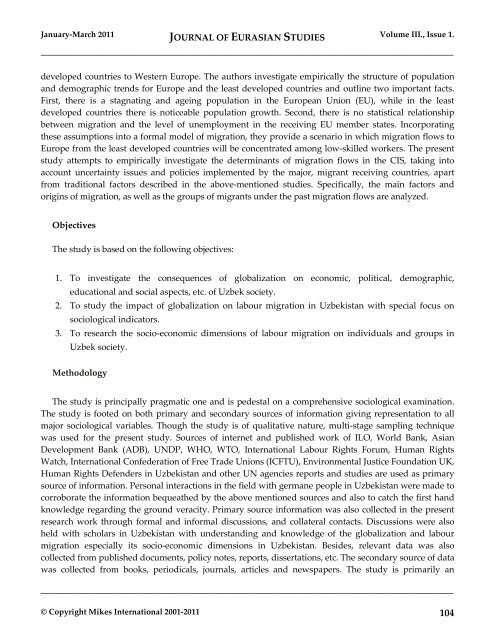JOURNAL OF EURASIAN STUDIES
JOURNAL OF EURASIAN STUDIES
JOURNAL OF EURASIAN STUDIES
You also want an ePaper? Increase the reach of your titles
YUMPU automatically turns print PDFs into web optimized ePapers that Google loves.
January-March 2011 <strong>JOURNAL</strong> <strong>OF</strong> <strong>EURASIAN</strong> <strong>STUDIES</strong> Volume III., Issue 1.<br />
_____________________________________________________________________________________<br />
developed countries to Western Europe. The authors investigate empirically the structure of population<br />
and demographic trends for Europe and the least developed countries and outline two important facts.<br />
First, there is a stagnating and ageing population in the European Union (EU), while in the least<br />
developed countries there is noticeable population growth. Second, there is no statistical relationship<br />
between migration and the level of unemployment in the receiving EU member states. Incorporating<br />
these assumptions into a formal model of migration, they provide a scenario in which migration flows to<br />
Europe from the least developed countries will be concentrated among low-skilled workers. The present<br />
study attempts to empirically investigate the determinants of migration flows in the CIS, taking into<br />
account uncertainty issues and policies implemented by the major, migrant receiving countries, apart<br />
from traditional factors described in the above-mentioned studies. Specifically, the main factors and<br />
origins of migration, as well as the groups of migrants under the past migration flows are analyzed.<br />
Objectives<br />
The study is based on the following objectives:<br />
1. To investigate the consequences of globalization on economic, political, demographic,<br />
educational and social aspects, etc. of Uzbek society.<br />
2. To study the impact of globalization on labour migration in Uzbekistan with special focus on<br />
sociological indicators.<br />
3. To research the socio-economic dimensions of labour migration on individuals and groups in<br />
Uzbek society.<br />
Methodology<br />
The study is principally pragmatic one and is pedestal on a comprehensive sociological examination.<br />
The study is footed on both primary and secondary sources of information giving representation to all<br />
major sociological variables. Though the study is of qualitative nature, multi-stage sampling technique<br />
was used for the present study. Sources of internet and published work of ILO, World Bank, Asian<br />
Development Bank (ADB), UNDP, WHO, WTO, International Labour Rights Forum, Human Rights<br />
Watch, International Confederation of Free Trade Unions (ICFTU), Environmental Justice Foundation UK,<br />
Human Rights Defenders in Uzbekistan and other UN agencies reports and studies are used as primary<br />
source of information. Personal interactions in the field with germane people in Uzbekistan were made to<br />
corroborate the information bequeathed by the above mentioned sources and also to catch the first hand<br />
knowledge regarding the ground veracity. Primary source information was also collected in the present<br />
research work through formal and informal discussions, and collateral contacts. Discussions were also<br />
held with scholars in Uzbekistan with understanding and knowledge of the globalization and labour<br />
migration especially its socio-economic dimensions in Uzbekistan. Besides, relevant data was also<br />
collected from published documents, policy notes, reports, dissertations, etc. The secondary source of data<br />
was collected from books, periodicals, journals, articles and newspapers. The study is primarily an<br />
_____________________________________________________________________________________<br />
© Copyright Mikes International 2001-2011 104

















